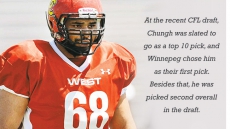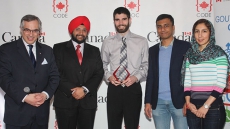Most of us aspire to have an extraordinary life, whether be it in politics, athletics or in our chosen careers. And then, there are those fortunate few, who are destined to fulfill their life’s calling – this is the case with Balbir Singh Dosanjh, known by his nickname Balbir Singh Sr.
From an early age, Singh exhibited tremendous aptitude and skill set to succeed in the sport of field hockey. Not only did Singh shine in field hockey throughout his adolescence and college years, but this prolific scorer ultimately represented an independent India (post British Raj and Partition) in the Olympic Games in 1948, 1952 and 1956. Singh secured three consecutive Olympic gold medals at these games, achieving the highest honour for an athlete to successfully represent their beloved nation.
Despite being a gifted, humble athlete, a national treasure, and three-time Olympic gold medalist, Singh has not been heralded in his home country as the legendary player that he is. Vancouver-based, award-winning journalist Patrick Blennerhassett travelled to India in 2014 to not only meet Singh and learn his life story, but to investigate why this incredible athlete has been overlooked. The result was the creation of the non-fiction book, AForgotten Legend: Balbir Singh Sr., Triple Olympic Gold & Modi’s New India.
A FORGOTTEN LEGEND
“To put it quite simply, Balbir is arguably India’s greatest Olympian, in a country that has over a billion people. However he is not a national hero in his homeland, and no one knows his extraordinary story,” says Blennerhassett. “His legend has been sorely forgotten over the years, and with this book, we hope to uncover him and present him to a new Canadian audience.”
A Forgotten Legend shines light on Singh’s journey of sheer will and determination to fulfill his life long calling, despite facing adversity and anonymity amongst India’s changing social, political and economic landscape from the British Raj era to present-day Modi’s India.
As you read the book, you are drawn into two different narratives that interweave – the first is Singh’s story told against the context of India and its history. And the second is Blennerhassett’s journey to India and the revelations and factual information he uncovers as he continues to investigate Singh’s life story from growing up as a child in Moga, Punjab, and playing field hockey for Khalsa College to working as a police officer during Partition and his travels around India and across the globe as a field hockey player, and later as a coach.
“Journalism is seen as the rough draft of history. With this book, I wanted to rewrite history factually and show people instead of what is being propagated over the Internet and what has become mythology over the years, strip that all away and just leave the facts, and let the facts speak for themselves,” explains Blennerhassett, who received the coveted Jack Webster Foundation Fellowship Award in 2007.
He goes on to say, “The idea was to not write an academic book, but a non fiction book that read like a story. We want to reach not only people who are interested in India and field hockey, but we want the average person from a kid in Burnaby to a mom in Surrey to pick it up and read it, and get something from it.” Sitting across from Singh, who is 92 years old, and Blennerhassett, you can see the camaraderie and mutual respect between the two. “Balbir’s story for me became my own labour of love… It’s an honour to tell Balbir’s story and I feel blessed to share his story with the world – he has become my hero,” adds Blennerhassett.

ON THE PITCH
“He darted from home straight onto the field, his little legs barely able to keep up with his excitement. Immediately he joined a game, running, galloping back and forth until he felt as if his tiny lungs were about to burst. That night he came home exhausted…When he awoke the next day, his rambunctious soul now had a purpose, and one purpose only – field hockey.” – excerpt from A Forgotten Legend.
Singh turns to me and says, “My first love is hockey and I’ve always wanted to play,” he then goes on to explain that his father gave him a very important gift for his seventh birthday – a field hockey stick. His father Dalip, a freedom fighter, may not have known it at the time that this fateful gift would steer his son in the direction of his life’s calling.
“I really like his story, the way he started playing hockey, he’s a self made man who recognized the talent in himself and wanted to play,” says Ujjal Dosanjh, former cabinet minister and BC premier. Dosanjh says his father would bring magazines home showcasing Singh’s pictures on the field, and he would tear the pages out and put them on his bedroom wall. “As a child, I knew of him fondly, as we were so proud of him – he was a humble giant of a player.”
Singh would play centre forward and be heralded for his “lightning shot that he could rip in a split second,” says Blennerhassett, adding “I always call him field hockey’s first power forward – he was the first player to combine speed and hands with size. He was also tough to knock off the ball.”
Nick Sandhu, former Team Canada, medal-winning field hockey player, similarly describes Singh’s style of play, “He had the quickest release in the game and had a wicked shot plus speed to get to places – the combination of all those three is deadly for any forward in any game,” says Sandhu. Singh’s ability to successfully score goals is evident during the Olympics, as he scored 22 goals over three Olympic games.
A friend’s father played with Singh in India, and shared stories with Sandhu about Singh’s sportsmanship. “He was so dedicated to his sport that he worked on his skills tirelessly. Singh was a good leader who led by example, if he wanted the other players to train hard, he was the first one to go train hard himself, he would only demand if he was going to do it himself.”
Sandhu first met Singh at the 1986 World Cup in London, and couldn’t believe “a man of his stature was so unbelievably humble” and over the decades, Sandhu says he was not only inspired by Singh’s achievements on the pitch, but by the life lessons bestowed by Singh to be a better person off the pitch.

THE LEGACY
Singh not only won three Olympic gold medals with his Indian hockey team, but the team went on to secure silver medals in the 1958 and 1962 Asian Games. In addition, he set an Olympic Record and Guinness World Record at the 1952 Olympics for scoring the most goals in a game – five goals against Netherlands, India won 6 to 1 clinching the gold medal. Singh’s love for hockey transitioned to coaching, and he victoriously led India’s team to clinching the 1975 World Cup.
Most recently, Singh was recognized at the 2012 London Olympics as one of 16 iconic Olympians. Singh, along with other incredible global athletes, including American Jesse Owens, were featured in an exhibit titled ‘The Olympic Journey: The Story of the Games’ at the Royal Opera House. Singh was the only Indian and the only field hockey player to receive this distinguished honour.
“Balbir represents the iconic Olympian. He is a pitch-perfect athlete, a hero who is incredibly humble and always one to give his teammates all the credit,” says Blennerhassett. “He is very idealistic, someone who has spent their entire life turning the other cheek, all the while achieving greatness in the process.”
Singh’s son Ringo Dosanjh reflects on his father’s legacy and says “I would like his legacy to show what the reality has been, rather then displacing him from the top position and fictionalizing the record of someone who is superior. The whole intent has been to get dad’s real story out so he’s not placed second to Dhyan Chand, but is in fact recognized as the best hockey player in the history of the game.”
Ujjal Dosanjh adds to this sentiment, “He’s a very humble man, I would remember him as an honest, decent Indian, the best hockey player the world ever produced.”
Singh holds a field hockey stick in his hand, and you can see the passion in his eyes for his sport. I ask him, ‘How would you like future generations to remember you?’ and he replies with a smile, “As a hockey player, as a real sportsmen.”
QUICK FACTS ON BALBIR SINGH SR.
London Olympics 1948 – Singh scored 8 goals in 2 games he played. The final was between Britain and an independent India, who was victorious 4-0 with Singh scoring the first two goals. Secured first gold medal.
Helsinki Olympics 1952 – Vice Captain and India’s flag bearer in the opening ceremony, scored 9 of India’s 13 goals. Set Olympic/ Guinness World Record for 5 goals in a game – 6 to 1 against Netherlands in the final. Secured second gold medal.
Set an Olympic Record and Guinness World Record at the 1952 Olympics for scoring the most goals in a game – 5 goals against Netherlands, India won 6 to 1.
Melbourne Olympics 1956 – Captain and India’s flag bearer. Singh broke a finger, missed a few group matches, but played in semifinal and final. India won gold against Pakistan 1 to 0.
Singh scored 22 goals over three Olympic games.





